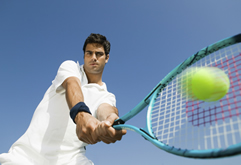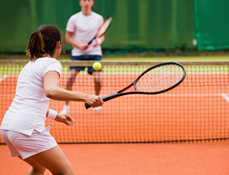
Sports Vision Training consists of the learning and training of Dynamic Visual Skills – that is “Vision in Motion”. These skills include Accommodation and Convergence, Anticipation Timing, Concentration under Stress, Depth Perception, Eye-Hand Coordination, Peripheral Awareness, Speed and Span of Recognition and Visual Reaction Time. (For more in-depth explanations, see the attached Visual Skills definition sheet.) These are all learned skills that can be improved with practice.
The following is an explanation of the most relevant dynamic visual skills associated with tennis. These are all learned skills that can be improved with practice.

The more rapidly a tennis player processes visual information, the faster he/she can position their body to hit the ball effectively with power. Excellent visual reaction time helps a player return a serve, a smash, play effectively at the net or simply return the ball into the opponent’s court.
Boris Becker’s serve has been clocked at 145 mph. This doesn’t allow much time to react. Even the speed of a normal rally shot requires a player to detect the speed and spin on the ball as quickly as possible in order to make the proper return. This means he/she must pick up the ball visually as it comes off the opponent’s racket.
Opportunities to make that proper return shot only present themselves for fractions of seconds, and in order to be effective (i.e. Quick, accurate and efficient), the reflex action of response must be automatic, not thought out.
Well-developed accommodative skills are important in tennis because both the ball and the opponent are in constant, rapid movement and the player has to be able to shift focus from the near to far or to intermediate targets instantaneously throughout the contest.
Eye tracking ability is also important. Quick, accurate saccades (or eye movements) are needed to rapidly survey the changing locations and movements of the opponent and the ball in relationship to the net, boundary lines, etc. Studies have shown that if the head has to move to aid in eye tracking, the performance is not only less efficient, but balance is thrown off too. The ultimate goal, regarding this visual skill and tennis, is to track the ball until contact can be made, not flinching on impact.
The visual system provides an individual with the information needed in order to appropriately act as well as the information needed to decide exactly when to act. For example, when receiving a serve, you have mere 100th’s of a second to read and react. You have to properly recognize the type of serve your opponent has chosen, as well as choose and prepare for your response. You can’t swing too soon or too late or you will miss the opportunity to make your shot. Timing must be perfect! The ability to anticipate is a major factor in high level competitive activities and even superior speed, size and reflexes cannot compensate for the insufficient processing of the visual information regarding when to perform.
This is an essential skill for a tennis player whether on defense or on the attack. The attacking player has to be distinctly aware of the speed and position of the oncoming ball in order to secure correct contact as well as remaining peripherally aware of the opponent’s position and the location of the court boundaries.
The defensive player must concentrate centrally on the attacking player’s court position and the likely direction the ball will come off his opponent’s racket. Meanwhile, he must be peripherally aware of the net and boundary lines of the court, etc. These factors all hold true for doubles too. However, in doubles, the players have the additional complication of being peripherally aware of where their partner’s body and racket are.
Other dynamic visual skills required for tennis are Concentration, Depth Perception, Eye Fatigue, Eye-Hand Coordination, and Visualization.